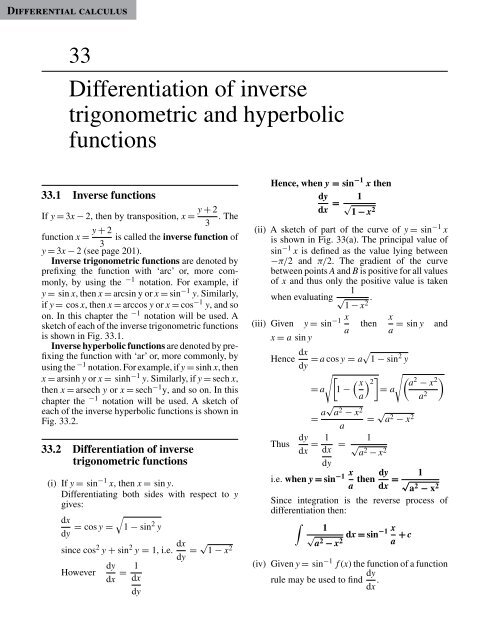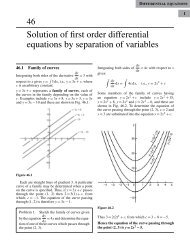differentiation
Create successful ePaper yourself
Turn your PDF publications into a flip-book with our unique Google optimized e-Paper software.
Differential calculus<br />
33<br />
Differentiation of inverse<br />
trigonometric and hyperbolic<br />
functions<br />
33.1 Inverse functions<br />
If y = 3x − 2, then by transposition, x = y + 2<br />
3 . The<br />
function x = y + 2 is called the inverse function of<br />
3<br />
y = 3x − 2 (see page 201).<br />
Inverse trigonometric functions are denoted by<br />
prefixing the function with ‘arc’ or, more commonly,<br />
by using the −1 notation. For example, if<br />
y = sin x, then x = arcsin y or x = sin −1 y. Similarly,<br />
if y = cos x, then x = arccos y or x = cos −1 y, and so<br />
on. In this chapter the −1 notation will be used. A<br />
sketch of each of the inverse trigonometric functions<br />
is shown in Fig. 33.1.<br />
Inverse hyperbolic functions are denoted by prefixing<br />
the function with ‘ar’ or, more commonly, by<br />
using the −1 notation. For example, if y = sinh x, then<br />
x = arsinh y or x = sinh −1 y. Similarly, if y = sech x,<br />
then x = arsech y or x = sech −1 y, and so on. In this<br />
chapter the −1 notation will be used. A sketch of<br />
each of the inverse hyperbolic functions is shown in<br />
Fig. 33.2.<br />
33.2 Differentiation of inverse<br />
trigonometric functions<br />
(i) If y = sin −1 x, then x = sin y.<br />
Differentiating both sides with respect to y<br />
gives:<br />
√<br />
dx<br />
dy = cos y = 1 − sin 2 y<br />
since cos 2 y + sin 2 y = 1, i.e. dx<br />
However<br />
dy<br />
dx = 1 dx<br />
dy<br />
dy = √ 1 − x 2<br />
Hence, when y = sin −1 x then<br />
dy<br />
dx = 1<br />
√<br />
1 − x 2<br />
(ii) A sketch of part of the curve of y = sin −1 x<br />
is shown in Fig. 33(a). The principal value of<br />
sin −1 x is defined as the value lying between<br />
−π/2 and π/2. The gradient of the curve<br />
between points A and B is positive for all values<br />
of x and thus only the positive value is taken<br />
1<br />
when evaluating √ .<br />
1 − x 2<br />
(iii) Given y = sin −1 x x<br />
then<br />
a a = sin y and<br />
x = a sin y<br />
Hence dx<br />
dy = a cos y = a√ 1 − sin 2 y<br />
[ ( ]<br />
√ (a x 2<br />
= a√<br />
1 − = a<br />
a) 2 − x 2 )<br />
a 2<br />
Thus<br />
= a√ a 2 − x 2<br />
a<br />
dy<br />
dx = 1 dx<br />
dy<br />
=<br />
= √ a 2 − x 2<br />
1<br />
√<br />
a 2 − x 2<br />
i.e. when y = sin −1 x dy<br />
then<br />
a dx = 1<br />
√<br />
a 2 − x 2<br />
Since integration is the reverse process of<br />
<strong>differentiation</strong> then:<br />
∫<br />
1<br />
√<br />
a 2 − x 2 dx = sin−1 x a + c<br />
(iv) Given y = sin −1 f (x) the function of a function<br />
rule may be used to find dy<br />
dx .










